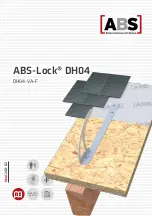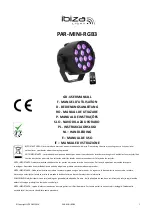
"AC ON" LED is illuminated when AC power is present.
NOTE: All models are supplied with an AC Lockout Circuit, which prevents the "EXIT" legend from illuminating when the battery is connected and no AC power is present.
NOTE: All models are supplied with a Low Voltage Disconnect circuit, which prevents damage to the battery from deep discharge during prolonged emergency operation.
NOTE: Batteries are often shipped in a discharged state - this is normal. The battery will require charging. Allow several hours of charge before testing the unit.
Models With SPECTRON® Self-Testing/Self-Diagnostic Circuitry
Models equipped with the SPECTRON self-testing/self-diagnostic electronics system provide:
■
Visual indication of AC power status
■
Visual indication of self-diagnostic test cycle
Visual indication of any unit malfunctions including:
■
Battery disconect
■
Battery fault
■
Transfer fault
■
Charger fault
■
Emergency Lamp fault
Spectron equipped units also include:
Brownout protection: unit will automatically transfer to emergency operation upon detection of low AC power (aproximately 80% of normal line).
Time Delay Retransfer: upon return of normal AC power, unit will remain in the emergency mode for an additional 15 minutes to allow AC power to stabilize.
LED Status Indicator
A bicolor LED (red/green) is provided on the control panel of all models equipped
with Spectron option.
Green Operating Status Indicator
The green Operating Status Indicator serves as both an AC power and self-test
indicator. During normal operation, the green Operating Status Indicator will be
illuminated, indicating the presence of AC power. During all automatic or manual
self-test cycles, the green Operating Status Indicator will blink at a 1 Hz rate.
Red Service Alert Indicator
Under normal operating conditions, the red Service Alert Indicator will remain off.
In the event the Spectron controller detects a malfunction, the red Service Alert
Indicator will blink at a 1 Hz rate, based on the following table:
Red Status Indicator Code Description
One blink ON/pause
Battery not connected
Two blinks ON/pause
Battery fault
Three blinks ON/pause
Charger fault
Four blinks ON/pause
Transfer circuit fault
Five blinks ON/pause
Emergency Lamp fault
Manual Tests
Using the unit test switch, users can initiate different duration test cycles
based on the following table:
Automatic Tests
The unit will automatically initiate a self-test/self-diagnostic cycle based
on the following table:
Initiating Action
Test Cycle
Press test switch once
1 minute
Press test switch twice
90 minutes
Testing Period
Duration of Test
Once a month
1 minute
Once every 6 months
Alternating:
30 minutes or 60 minutes
MAINTENANCE
TROUBLE SHOOTING
●
"EXIT" legend does not illuminate
- check wiring connections
●
Emergency Circuit does not work
- Batteries are shipped uncharged and disconnected. Connect power pack leads charge before testing.
- Make sure charger board is properly seated.
- Check wiring connections.
MAINTENANCE
Signs should be tested and maintained in accordance with National Electrical Code and NFPA 101 Life Safety Code requirements. It is recommended that emergency exit
signs be tested for 30 seconds once a month and for 90 minutes once a year.
RECYCLING INFORMATION
All thermoplastic parts are recyclable.
All cartons contain recycled materials.
Please recycle responsibly.
NOTICE:
Emergency model exit signs contain rechargeable Nickel Metal Hydride batteries which must be recycled or disposed of properly.
Hubbell Lighting, Inc. Life Safety Products • www.dual-lite.com
Copyright© Hubbell Lighting, Inc., All Rights Reserved • Specifications subject to change without notice. • Printed in U.S.A.
■
■
■
■
■
■
■
Red Status Indicator Code Description
One blink ON/pause
Battery not connected
Two blinks ON/pause
Battery fault
Three blinks ON/pause
Charger fault
Four blinks ON/pause
Transfer circuit fault
Five blinks ON/pause
Emergency Lamp fault
Initiating Action
Test Cycle
Press test switch once
1 minute
Press test switch twice
90 minutes
Testing Period
Duration of Test
Once a month
1 minute
Once every 6 months
Alternating:
30 minutes or 60 minutes
●
●
IMPORTANT SAFEGUARDS
When using electrical equipment, basic safety precautions should always be followed including the following:
READ AND FOLLOW ALL SAFETY INSTRUCTIONS
1. Do not use outdoors.
2. Do not let power supply cords touch hot surfaces.
3. Do not mount near gas or electric heaters.
4. Equipment should be mounted in locations and at heights where it will not readily be subject to tampering by
unauthorized personnel.
5. The use of accessory equipment not authorized by the manufacturer may cause an unsafe condition.
6. Do not use this equipment for other than its intended purpose.
7. Servicing of this equipment should be performed by qualified service personnel.
8. Test cycling: the Life Safety Code (NFPA 101) requires testing of emergency exit signs once a month for a
minimum of 30 seconds and once a year for a minimum of 90 minutes
.
INSTALLER:
• SEE UNIT LABLE FOR ADDITIONAL MODEL SPECIFICATIONS
• SAVE THESE INSTRUCTIONS FOR USE BY OWNER/OCCUPANT
WARNING - This product contains chemicals known to the State of California to cause cancer, birth defects, and/or other reproductive harm.
Thoroughly wash hands after installing, handling, cleaning, or otherwise touching this product.
Thermoplastic LED Exit Sign
Installation, Operation , and Maintenance Instructions
EVE Series
OPERATION
93048330_3
MAINTENANCE
LABEL




















